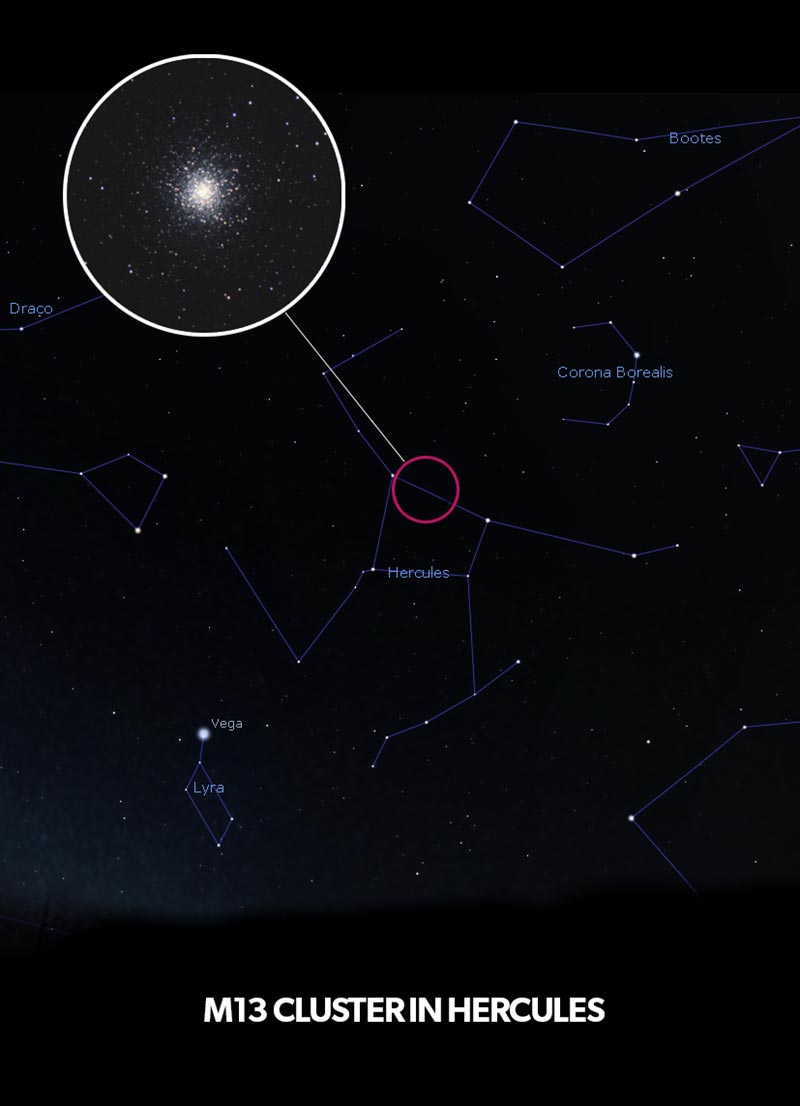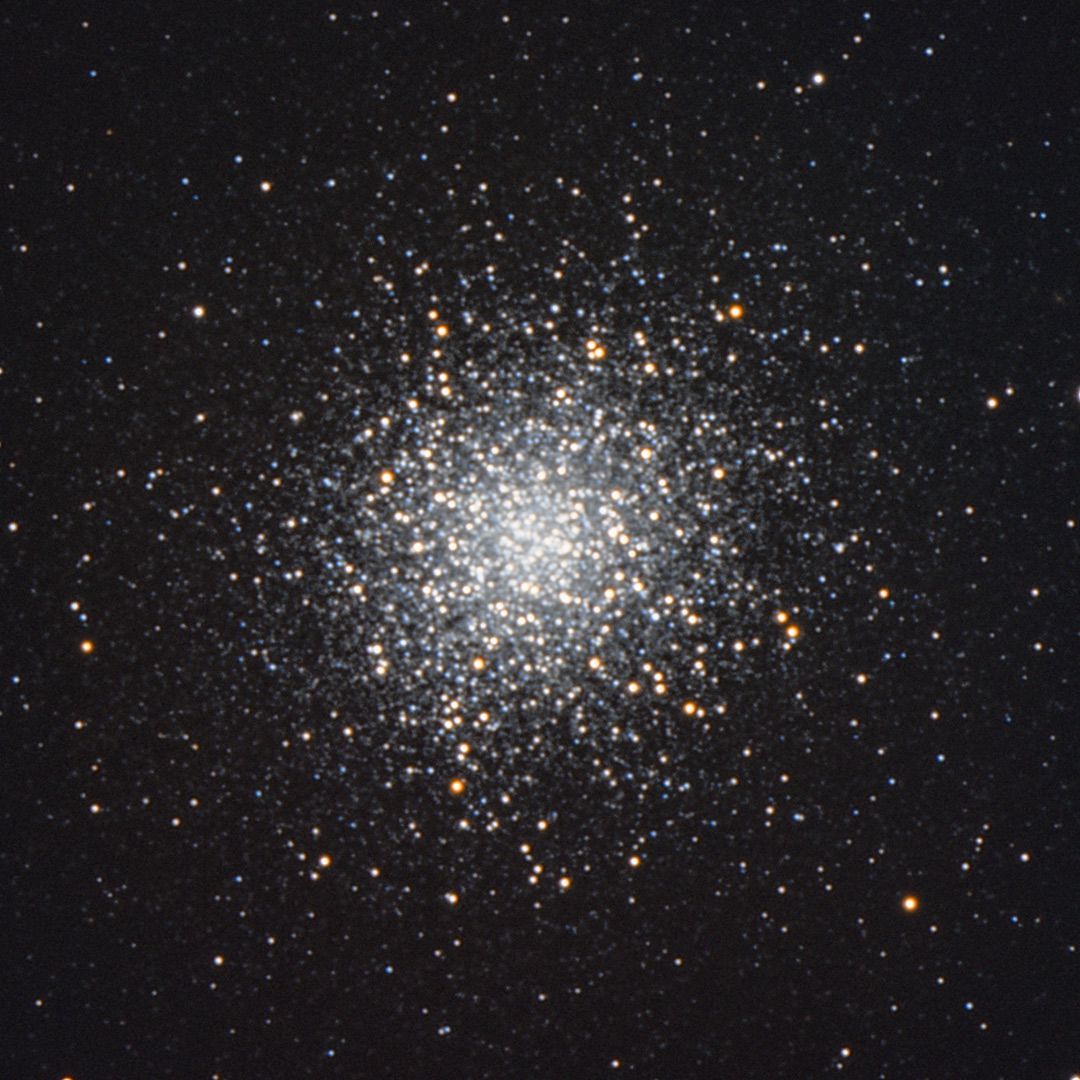Hercules Constellation
Hercules is the fifth-largest constellation, taking up a total of 1,225 square degrees in the night sky. Despite its size, this constellation can be challenging to see because of its dim stars. The Keystone asterism, which represents the torso of Hercules, will help you find it.
It is an ancient constellation from ancient times, named after the Roman version of the Greek hero Hercules. The traditional depiction of Hercules shows him kneeling with his hand raised above his head. The star Alpha Herculis, also known as Rasalgethi, translates to ‘head of the kneeling one’.
This constellation contains Messier 13 (NGC 6205), the brightest globular cluster in the northern hemisphere, which is best seen from May through to July.
Hercules Constellation Details
- Symbolism: The Kneeler, the Kneeling One
- Brightest star: Beta Hercules (Kornephoros)
- Number of stars: 11 formally named stars
- Size: 1,225.1 square degrees
- Right Ascension: 16h 00m 26.64s and 18h 57m 49.50s
- Declination: +3.67° and +51.32°
Stars in the Hercules Constellation
Though there are many stars in the constellation Hercules, below is a list of the main stars that make up the shape of the constellation:
- Alpha Herculis (Rasalgethi)
- Beta Herculis (Kornephoros)
- Gamma Herculis
- Omega Herculis (Kajam)
- Delta Herculis (Sarin)
- Lambda Herculis (Maasym)
- Mu Herculis (Marfak)
- Zi Herculis
- Omicron Herculis (Atia)
- Epsilon Herculis (Cujam)
- Zeta Herculis
- Eta Herculis (Sophian)
- Pi Herculis
- Theta Hercules (Rukbalgethi Genubi)
- Iota Herculis
- Tau Herculis (Rukbalgethi Shemali)
The brightest star in Hercules is Beta Herculis, also known as Kornephoros, meaning ‘the club bearer’. This star is a yellow-white giant with a visual magnitude of 2.8 and 148 light-years from Earth.
Hercules Constellation | IAU & Sky and Telescope
Keystone Asterism
Like many constellations, Hercules has an asterism. These are recognizable shapes that are not officially categorized as constellations, such as the Big Dipper.
This particular asterism, known as the Keystone, gets its name from the shape of a ‘key stone’ or the main supporting stone in an archway. The keystone, comprised of four bright stars, represents Hercules’ toro in a recognizable wedge-shape.
The four stars that make up the Keystone asterism are:
- Pi Herculis
- Eta Herculis
- Zeta Herculis
- Epsilon Herculis
Keystone Asterism | Made using Stellarium Web
With limited bright stars in this constellation, the Keystone asterism is a useful tool to help locate the Hercules constellation.
How to find the Hercules Constellation
Hercules only contains two stars brighter than magnitude three, so it can be difficult to see the Hercules constellation in its entirety. Luckily, there are many aids to help you find this large constellation.
Locate the Keystone:
- Look for the Keystone asterism, which consists of four stars that form a wedge-shape depicting Hercules’ torso.
- The rest of the constellation stars will surround this asterism and can be found by connecting the imaginary lines between the constellation stars.
Another way to find the Hercules constellation is to use the bright stars Vega and Arcturus as reference points:
Locate Vega and Arcturus:
- Locate Vega in the constellation Lyra, and Arcturus in the constellation Boötes.
- Draw an imaginary line from Vega through to Arcturus
- Hercules will be located near the point where this imaginary line intersects the western horizon. Look for the Keystone asterism, which will help to identify the shape of the constellation
You may have heard the saying ‘Can you handle Hercules’. This is a saying used to find the Hercules constellation.
Locate the Big Dipper:
- Locate the Big Dipper
- Use only the straight part of the Big Dipper’s handle and extend a line from it until you hit a brightish star in the Keystone asterism
Lastly, this constellation is bordered by Draco to the north, Boötes to the east, Ophiuchus to the southwest, and Lyra to the west.
When can you see Hercules?
Hercules is visible in the mid-northern latitudes from April to November. The best time to observe is in the summer months throughout July and August when it is highest in the night sky. Those in the southern hemisphere can look for Hercules from June to September.
Deep Sky Objects
There are several noteworthy deep-sky objects in the Hercules constellation.
- M13 (NGC 6205): a large and bright globular cluster containing hundreds of thousands of stars located between the Keystone stars, Zeta and Eta. Also known as the Great Globular Cluster in Hercules, it is the brightest globular cluster in the northern hemisphere. With a magnitude of 5.78, this object is visible to the naked eye under the right observing conditions.
Globular Cluster M13 | Trevor Jones
- M92 (NGC 6341): one of the oldest globular clusters in our galaxy and is estimated to be over 14 billion years old. Like other globular clusters, it is a tightly packed collection of stars which can be seen with the naked eye under very good viewing conditions.




